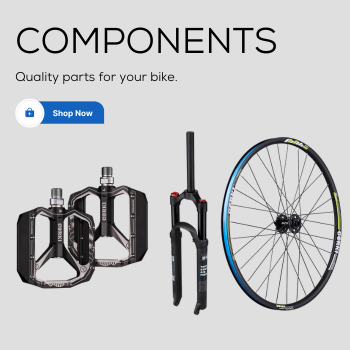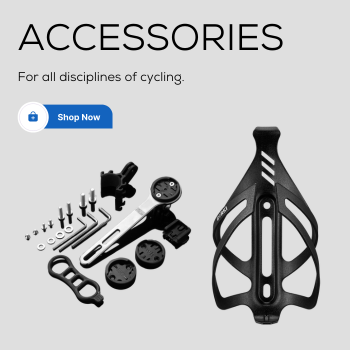
The Role of Braking Systems: Upgrading Your Bike's Stopping Power
Types of Braking Systems
Bicycle brakes are important for slowing down or stopping a bike. There have been various designs of bicycle brakes over time, with some being more popular than others. It's important to choose the right brakes for your needs.
Rim Brakes
The classic choice, known for being lightweight and wallet-friendly. Rim brakes operate by squeezing brake pads against the wheel's rim. However, their effectiveness can diminish, especially in wet conditions, making them a less ideal choice for all-weather riders.
C-Brakes (Caliper Brakes)
Cyclists who enjoy road biking or leisure city cruising will find C-brakes to be a reliable way to stop. These brakes work by squeezing brake pads against the wheel's rim and can be found on many road bikes. While not as complex as disc brakes, they still provide dependable performance and are a popular choice for riders who prefer a simpler braking system.
V-Brakes (Linear Pull Brakes)
V-brakes are a common and efficient braking system used on mountain bikes and city cruisers. These brakes, formally known as linear-pull brakes, employ a V-shaped mechanism, enhancing their stopping power. V-brakes offer a robust braking solution that balances efficiency with simplicity.
Disc Brakes
Mechanical Disc Brakes
A modern favorite, disc brakes have gained popularity for their consistent stopping power regardless of the weather. They operate by clamping down on a rotor attached to the wheel hub. While they shine in all conditions, be prepared to invest a bit more in this upgrade.
Hydraulic Brakes
At the zenith of braking technology, hydraulic brakes bring unparalleled stopping power with reduced maintenance needs. Instead of relying on cables, hydraulic brakes use brake fluid to transmit force, resulting in smoother and more responsive braking. The catch? Your pocket might feel a bit lighter. It requires more complex maintenance compared to mechanical systems.
Coaster Brakes
Coaster brakes are commonly found on cruiser and city bikes inside the rear hub. To engage the brake, you pedal backward. Despite the availability of more advanced brake systems, there will always be a place and fans for simple and low-maintenance technology.

Factors to Consider When Upgrading
Several important factors must be considered before you upgrade. From rim to disc brake, this decision can significantly impact your riding experience, so it's crucial to take the time to think it through. Let's take a look at the key factors you should keep in mind before making any changes.
Riding Style and Terrain
Going for the most advanced system is tempting, but setting a realistic budget that aligns with your overall bike upgrade goals is important. Consider your riding needs, whether it's mountain biking, road cycling, or leisurely city cruising. For example, riders who primarily use their bikes for casual rides in fair weather conditions and don't encounter challenging terrains may find rim brakes sufficient for their needs. Disc brakes may be seen as an unnecessary expense in such cases.
Types of Bikes
Different types of bicycles require different upgrade plans. For road biking, rim brakes usually suffice. However, if you're a road cycling enthusiast looking for better performance, upgrading to disc brakes can provide improved stopping power and control. It's important to note that disc brakes have been used in mountain biking for a long time but are relatively new to road bikes. More and more road cyclists are now using disc brakes because they recognize their advantages, which include better modulation and consistent performance, especially in different weather conditions and challenging terrains.
Budget
Your budget plays a crucial role in determining the scope of your braking system upgrade. Braking systems come in various prices, from budget-friendly options to high-performance models. While it's tempting to aim for the most advanced system, setting a realistic budget that aligns with your overall bike upgrade goals is essential.
Disc brake systems, especially hydraulic ones, can be more expensive than traditional rim brake systems. And it needs some specialized knowledge for constant maintenance. Cyclists on a tight budget may prioritize other upgrades or maintenance over disc brakes.

Compatibility with the Bike Frame and Fork
It's important to know that not all bike brakes fit every bike frame and fork. To make sure the new brakes fit your bike, check its specifications, including the type of brakes it currently has, the size of the wheel rims, and the available mounts for brake calipers.
If you're changing from rim to disc brakes, you may need adapters to fit them. These adapters connect the existing mounts on your bike to the new braking system. Be aware of any extra parts or changes you need to make the upgrade work.
Upgrading to Disc Brakes
If you have considered the three factors mentioned earlier and still think that disc brakes are the best choice for you, congratulations! You are now ready to join the club of disc brake enthusiasts. In the next section, we will discuss the benefits of mechanical disc brakes and provide you with a step-by-step guide for upgrading.
Advantages of Upgrading to Disc Brakes
- Increased Stopping Power: Disc brakes are known for their strong stopping power. They have larger brake pads and a bigger surface area, which helps them stop quickly. This is especially important when you must stop suddenly or go downhill. Upgrading to disc brakes will help you control your speed with precision.
- Improved Modulation and Control: Disc brakes are also great because they allow you to control the braking force with finesse. You can adjust the amount of force you use to slow down gradually or stop quickly. This is especially useful when you're riding on different terrains or in unpredictable conditions.
- Better Performance in Wet and Muddy Conditions: Unlike traditional rim brakes, disc brakes work well in wet or muddy conditions. They don't lose effectiveness because the braking surface is separate from the wheel rim. This means you can rely on them to stop you, no matter the weather. This is especially important when you're riding in the rain or on rough terrain.
Step-by-Step Guide for Upgrading to Disc Brakes
- Remove the Old Braking System: Begin the upgrade process by bidding farewell to the existing braking system. This may involve removing brake levers, cables, and calipers, depending on your current setup. Take note of the components for reference during the installation of the new system.
- Install the Disc Brake Caliper and Rotor: With the old system out of the way, it's time to introduce the new components. Mount the disc brake caliper onto the designated mounts on your bike's frame or fork. Attach the rotor to the wheel hub, ensuring proper alignment. Tighten all bolts securely to prevent any wobbling or misalignment.
- Bleed the Hydraulic Brake System (if applicable): If you've opted for hydraulic disc brakes, bleeding the system is crucial. Follow the manufacturer's instructions for your specific brake model. Bleeding removes any air bubbles from the hydraulic fluid, ensuring optimal performance and consistent braking pressure.
- Adjust the Brake Pads and Caliper Alignment: Proper alignment of the brake pads with the rotor is essential for even braking and preventing premature wear. Adjust the position of the caliper to ensure that the brake pads make full contact with the rotor without rubbing when the brakes are disengaged. This step is critical for optimal performance and longevity.
- Test the Braking Performance and Make Necessary Adjustments: Before hitting the road, take your bike for a test ride in a controlled environment. Evaluate the braking performance and responsiveness. Make any necessary adjustments, such as fine-tuning the lever reach, adjusting pad contact points, or addressing any issues with the lever feel. This hands-on testing ensures that your upgraded disc brakes meet your specific riding preferences.
Upgrading to Hydraulic Brakes
Both mechanical and hydraulic disc brakes are types of disc brakes used in bicycles. Hydraulic disc brakes use oil to transmit force when the hydraulic handle is pulled, which moves the piston in the brake caliper to clamp the disc. These brakes are popular among mountain bikers and are gaining popularity among advanced road bikes.

Benefits of Upgrading to Hydraulic Brakes
- Enhanced Stopping Power and Modulation: Hydraulic brakes operate on the principle of hydraulic fluid transmission, providing unparalleled stopping power. The hydraulic force delivers consistent and precise braking, allowing for fine modulation. This means you can control your braking force with finesse, an essential feature for various riding scenarios.
- Reduced Hand Fatigue: Unlike traditional cable-actuated brakes that require more manual effort, hydraulic systems operate with greater efficiency. The reduced hand fatigue is especially noticeable during extended rides or when navigating challenging terrains. With hydraulic brakes, you exert less force to achieve the same or even superior braking performance.
- Smoother and More Consistent Braking: Hydraulic brake systems are less susceptible to cable stretch and wear, leading to smoother and more consistent braking. The sealed hydraulic system prevents contaminants from affecting brake performance, ensuring reliability over time. The consistent feel of hydraulic brakes adds an extra layer of confidence to your rides.
Step-by-Step Guide for Upgrading to Hydraulic Brakes
- Remove the Old Braking System: Begin by bidding farewell to your existing braking system. Remove brake levers, cables, and calipers, ensuring a clear slate for the hydraulic upgrade. Take note of how the old system is configured for reference.
- Install the Hydraulic Brake Lever and Caliper: Mount the hydraulic brake lever on your handlebars comfortably and ergonomically. Install the hydraulic caliper on the designated mounts on your bike's frame or fork. Ensure that the lever and caliper are securely fastened.
- Cut and Route the Hydraulic Brake Hose: Measure and cut the hydraulic brake hose to the appropriate length, considering the routing along your bike frame. Avoid sharp bends or kinks in the hose, which can impact brake performance. Secure the hose with zip ties, keeping it neatly routed and away from moving parts.
- Bleed the Hydraulic Brake System: Bleeding is critical in ensuring optimal hydraulic brake performance. Follow the manufacturer's instructions for bleeding your specific brake model. Bleeding removes any air bubbles from the hydraulic fluid, maintaining consistent pressure and responsiveness.
- Adjust the Brake Lever Reach and Lever Angle: Customize the brake lever reach and angle to match your hand size and riding preferences. Proper adjustment ensures a comfortable and ergonomic grip, reducing hand fatigue during extended rides.
- Test the Braking Performance and Make Necessary Adjustments: Conduct a test ride in a controlled environment before hitting the road. Evaluate the braking performance and responsiveness. Make any necessary adjustments, such as fine-tuning the lever reach, adjusting pad contact points, or addressing any issues with the lever feel. This hands-on testing ensures that your upgraded hydraulic brakes meet your specific riding preferences.
Conclusion
Upgrading your bike's braking system is a smart move that can enhance your cycling experience. It's not just a trend but a commitment to safety and control. You have two options: disc brakes or hydraulic systems. Both offer clear benefits. By upgrading your brakes, you're investing not only in your bike but also in your ride. So, take that leap and upgrade your brakes.




